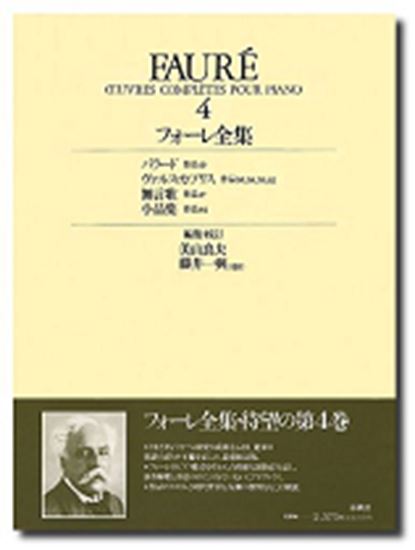Fauré, Gabriel : 8 Pieces breves Op.84
Work Overview
Publication Year:1902
First Publisher:Hamelle
Instrumentation:Piano Solo
Genre:pieces
Total Playing Time:19 min 30 sec
Copyright:Public Domain
Commentary (1)
Author : Saitoh, Noriko
Last Updated: October 1, 2007
[Open]
Author : Saitoh, Noriko
This collection of 8 short pieces was published in 1902, gathering works composed at different times. It is dedicated to Madame Jean Léonard-Koechlin. The titles for each piece were added by the publisher at the time of publication. However, the eighth piece, which concludes this collection, is identical to Nocturne No. 8.
No. 1: Capriccio
The first piece, "Capriccio," was composed in 1899 for that year's graduation examination at the Paris Conservatoire. It is in E-flat major, 9/8 time, marked Andante quasi Allegretto. Ties are used throughout.
No. 2: Fantaisie
The second piece, "Fantaisie," is believed to have been composed in 1902. It was premiered by Ricardo Viñes at the Société Nationale de Musique in April 1903. The autograph manuscript of this work, discovered in Washington, is titled "Feuillet d'album" (Album Leaf). It is in A-flat major, 2/4 time, marked Allegretto moderato. The melody is characterized by dotted rhythms. The frequent use of Neapolitan sixth chords is also striking.
No. 3: Fugue
The third piece, "Fugue," was composed in June 1869. According to Orledge, this fugue is based on a fugue Fauré composed on his own subject to win a composition prize while he was a student at the École Niedermeyer (around 1863). It is in A minor, 4/4 time, marked Andante moderato. Written in four voices, it constantly modulates. At the end of the piece, it shifts to the parallel major, A major, and a 10-measure coda is added. Considering Fauré's youth when this fugue was written, his skill is evident in the composition of the transposed coda using the main subject of the fugue.
No. 4: Adagietto
The fourth piece, "Adagietto," was composed in 1902 and premiered by Ricardo Viñes at the Société Nationale de Musique in April of the following year. It is in E minor, 3/4 time, marked Andante molto moderato. Although written in E minor, modal elements are strongly felt, and the harmony creates a unique atmosphere. In this piece, the melody resonates in the inner voices and is sung throughout. And it is treated as a kind of variation.
No. 5: Improvisation
The fifth piece, "Improvisation," was composed in 1901 for that year's graduation examination at the Paris Conservatoire. It is in C-sharp minor, 4/4 time, marked Andante moderato. Arpeggios passed between the left and right hands are characteristic. It shifts to the parallel major, C-sharp major, to conclude the piece.
No. 6: Fugue
The sixth piece, "Fugue," was composed in 1869. This fugue, like the third piece, is also believed to be based on a fugue Fauré composed while he was a student at the École Niedermeyer. It is in E minor, 3/4 time, marked Andante moderato. It is written in four voices. While it is difficult to clearly present the subject's rhythm in this fugue, this difficulty stems more from its polyphonic, chamber-music-like nature rather than from piano technique.
No. 7: Joie
The seventh piece, "Joie" (Joy), was composed in 1902 and premiered by Ricardo Viñes at the Société Nationale de Musique in April of the following year. It is in C major, 6/8 time, marked Allegro giocoso. Throughout the piece, the rhythm of sixteenth-note triplets is dominant, which is believed to contribute to its "giocoso" character.
No. 8
As mentioned earlier, the eighth piece is identical to Nocturne No. 8.
Movements (8)
PTNA & Partner Channel Videos(6items)
Sheet Music
Scores List (4)

(株)全音楽譜出版社

(株)春秋社

(株)全音楽譜出版社

(株)全音楽譜出版社






